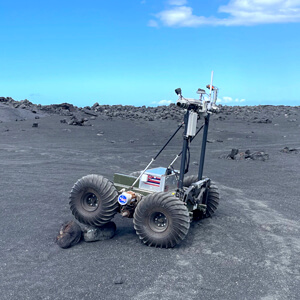
A dedicated group of software engineering students at the University of Hawaiʻi at Hilo has completed a year-long project to upgrade the software on a planetary rover. The rover, named Helelani, will be used for testing by space agencies around the world.
Helelani weighs 700 pounds and is equipped with a variety of instruments and imaging systems. It can be controlled remotely and is designed to navigate the rugged terrain on Hawaiʻi Island, which is similar to the landscapes on the Moon and Mars.
UH Hilo students AJ Garcia, Daniel Malone, Jaden Matsunaka and Richard Sevao served as interns at the campus’ Pacific International Space Center for Exploration Systems (PISCES). PISCES is a program that focuses on research and education related to Earth and space exploration.

Under the guidance of Christian Andersen, PISCES research director, the students updated the rover’s software code. They also received support from H. Keith Edwards, a computer science professor who mentored the students in a two-semester software engineering class.
“This is a good type of project for software engineering classes since students are forced to work with someone else’s code and understand how it works, which is quite similar to what happens in their first software development job,” said Edwards.
Hands-on Learning
Undergraduates at UH Hilo use the rover for hands-on experience in robotics, engineering and programming. Each year, a group of Edwards’ students work on the rover’s hardware and software systems as part of an internship program.
According to Edwards, the project gave students the opportunity to learn about the structure of the code that runs Helelani and understand how it works.
“They were also able to update the operating system for the mission control station and were able to get the code base to work with the new operating system,” said Edwards.
Next: Fine-tuning a 360-degree camera
The students also experimented with implementing a new 360-degree camera into the rover. The work will continue with a new group of students this coming school year.
For more go to UH Hilo Stories.
–By Susan Enright

